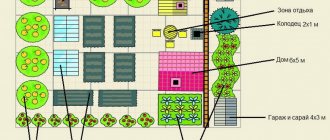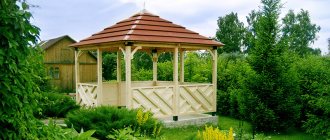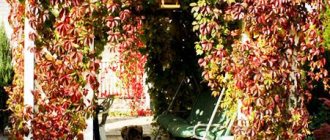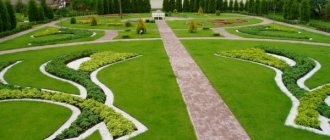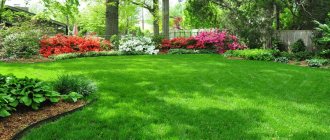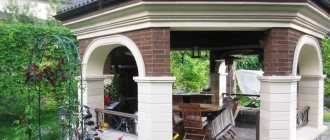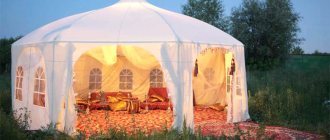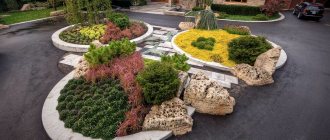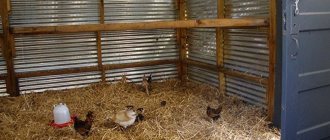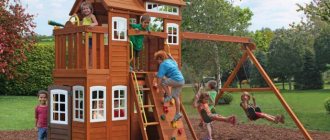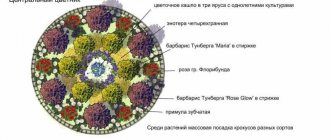One of the current trends in the development of domestic landscape design is a return to the forgotten traditions of Russian gardening art. And it pleases. After all, landscape design in the style of a Russian estate is that rare case when a man-made garden ideally “fits” the climate, weather, soil, and nature of the area. We invite you to talk about the forgotten, but so familiar appearance of a Russian estate.
Classic "noble nest"
Follow us:
Landscapes of Russian estates: from the history of style
The heyday of Russian noble estates is considered to be the end of the 18th - beginning of the 19th centuries. During this period, wealthy nobles and landowners laid out gardens according to all the canons of the French regular style - with parterre flower beds, fountains and sculptures. A mandatory element was a greenhouse with heat-loving plants and neatly trimmed hedges.
But a century later, trends are changing. Most estates are falling into disrepair and maintaining expensive classic designs is becoming increasingly difficult. As a result, only the front area retains a more or less decent appearance, while the rest of the garden and park fall into disrepair.
Gradually, the gardens of noble estates acquired the features of a landscape style with shady alleys, secluded abandoned gazebos and secret benches buried in thickets of lilac and mock orange. This is how the famous Russian style arises - slightly careless, sometimes neglected and terribly romantic.
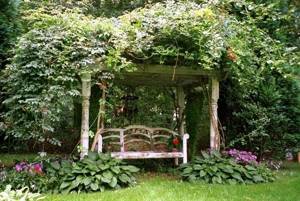
A gazebo with peeling paint that remembers better times
Garden area and vegetable garden
Fruit trees and shrubs are an invariable component of the Russian estate style. Apple tree, pear tree, plum tree, sea buckthorn, honeysuckle, raspberry, currant and gooseberry have always been popular garden plants in our country.
Medicinal and spicy plants, as well as some vegetables, are grown in small beds, often hidden from prying eyes behind hedges.
Russian estates in paintings by artists
Russian painters have always managed to convey the special atmosphere of estates and their gardens.
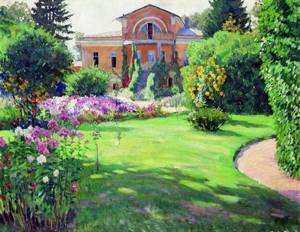
Painting by Sergei Vinogradov “Estate”
Sergei Vinogradov’s painting “The Estate” depicts an old brick mansion with a round balcony, which is literally surrounded by greenery and flowers. We can practically hear the scent of the garden and are transported to this sunny day to stroll along the winding paths.
The beauty of the landscapes of Russian estates always inspired the artist and he sought to convey this on his canvases. They invariably resonated with the public, and rich people literally lined up to order a painting from him.
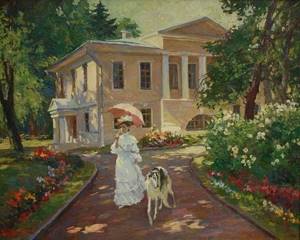
Painting “Warm morning. Estate"
The painting “Warm Morning” is no less atmospheric. Estate" by another Russian painter. Here we see a lady walking leisurely along a shady alley, admiring the beauty of the surrounding landscape. It seems that even the greyhound has stopped its run to join in the contemplation of the harmony of nature, recreated by the caring hands of man.
Looking at such pictures, we understand why landscape design in the style of Russian estates is currently coming back into fashion.
The appearance of a Russian garden
Coloristics
The colors used in such a garden are light, calm - sand, a shade of fresh wood, white, blue, the whole spectrum of green, soft apricot. Flowers in flower beds or ornamental shrubs will become bright accents. Garden sculptures in pastel colors will highlight the lush green foliage.
Plants
As mentioned above, a Russian estate has never existed without a garden. It will not be possible to recreate the grandeur and scope of the gardens described in the works of the classics on a small summer cottage. But you can try and make sure that a modest and elegant garden with elements of a manor style pleases the eye and soul.
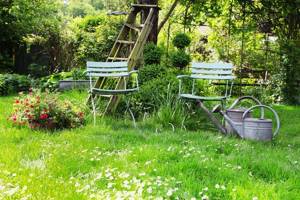
For a Russian-style garden, there is naturally a reasonable combination of beauty and practicality, so you can safely place a greenhouse next to the rose garden. But it is still more logical to divide the garden area into several parts, the location of which will depend on the taste of the gardener and on the size of the plot. Each part will be populated with certain plants and decorated differently from the others.
Flower beds are made as bright and colorful as possible. You should not decorate them with stones or decorative fences. Simply planting a scattering of flowers is enough. When they bloom, the multi-colored “cap” will hide all design flaws if they were made during the planting process. Therefore, you need to pay attention to the flowering period of plants; it should be approximately the same to create that very “cap”.
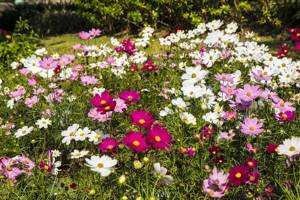
Among annual plants, preference is given to aster, calendula, cosmos, petunia, and nasturtium. Perennial plants will also look good in the flowerbed: columbine (aquilegia), bells, carnations, phlox, lupins, garden daisies, aconites. Bulb plant lovers need not worry - their favorites will not be left out. Tulips and daffodils, hyacinths and lilies - there is enough room for everyone.
When decorating flower beds in the style of a Russian estate, do not forget about irises, primroses, marigolds, dahlias, gilly leaves, sweet peas and decorative (winged) tobacco. These plants have long been familiar to almost every gardener and do not require special skills in cultivation and care. Perfect for beginners who have decided to create a Russian garden at their dacha.
It is worth noting that flower beds do not need to select plants based on color and height. Moreover, landscape designers are for mixborders with both hands.
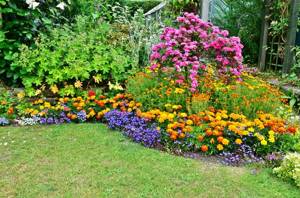
A flower garden of free outlines, in which plants of different heights, flowering periods and types coexist peacefully. A well-groomed and well-planted mixborder will add a fresh note to the appearance of a Russian garden.
It is appropriate to use wildflowers, as well as plants with a strong aroma - these are water mint, thyme (thyme) and fenugreek. It is better to plant them not in flower beds, but along paths, so that when walking along them you can enjoy the spicy aroma.
Red and white creeping clover will perfectly decorate open areas of the garden and at the same time strengthen the soil. It can be combined with other forage plants. The remaining open spaces can be sowed with speedwell, bedstraw or marianberry.
Considering that a Russian garden implies the presence of trees that provide abundant shade, it is worth choosing suitable shade-tolerant plants in advance. Natural views are combined with decorative ones. The following plants will grow well in partial shade: periwinkle, jasmine, fern, lily of the valley, and lungwort.
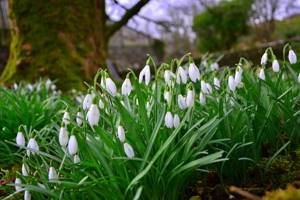
You can’t do without primroses so that the garden is beautiful not only in summer and autumn, but also in early spring. Crocuses, iridodictiums: purple, yellow, white, blue and, of course, snowdrops.
In well-lit and most visible places you can build a small rose garden. Tall, bright sunflowers planted in peculiar islands will also look organic.
The highlight of such a garden will be some kind of apothecary garden with mint, oregano and hyssop.
Shrubs
A typical Russian flavor is conveyed by fragrant shrubs: jasmine, lilac.
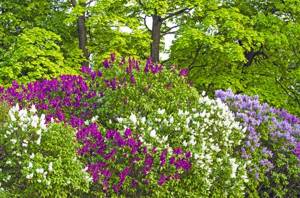
The raspberry, gooseberry and currant bushes will not only please the eye, but also produce a harvest. Every gardener already has them, so if you decide to remodel your existing garden, there will be no problems purchasing them.
You can supplement existing shrubs with viburnum and barberry.
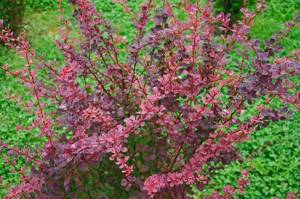
An original shrub, the European euonymus, will help add a drop of brightness. It has a dense and spreading crown with a height of 1.5 to 3 m. A very interesting plant that blooms profusely in May and June. The flowers are small, yellowish-green, unfortunately, almost invisible. But with the onset of autumn, the euonymus will decorate the garden with fancy pink-red fruit boxes.
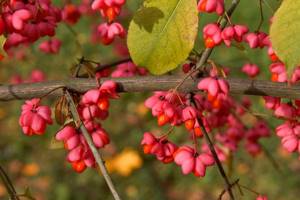
If there are children in the family, you should not plant euonymus, since its bright fruits are poisonous (they have a strong laxative and emetic effect).
Safe and unpretentious, but no less lush and bright, viburnum leaf. The color of its foliage depends on the variety and can be yellow, dark green, purple or dark red. The use of bladderwort in a Russian garden can be varied: planted singly on the lawn, placed under a tree canopy or even in a flower garden, or added to large coniferous plants: thuja or juniper. An interesting experiment would be to plant it next to smaller deciduous shrubs and herbaceous perennials. Choosing a place and neighbors for a bladderwrack gives scope to the gardener’s imagination and personal preferences.
Trees
A Russian garden cannot get by with flowers and shrubs alone; it also needs to be landscaped with trees. Deciduous, coniferous, but most often fruit, since they are both beautiful and useful, and do not take up very much space (considering the area of the plot).
Apple trees (including wild ones), pears, cherries - something that has long been familiar and loved by everyone.

You can diversify fruit trees with apricots and cherries, provided the climate is favorable for them. Sea buckthorn and rowan are worthy touches to the overall picture of the Russian garden. They will both perform a decorative function and bring a harvest.
If the owner of the dacha is lucky and has a large plot of land available, the queens of Russian noble estates - linden trees - are suitable for planting.
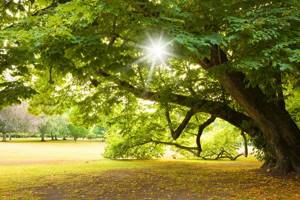
As an option, it is recommended to plant or not cut down if they are already growing: spruce, pine, birch, oak, maple.
Landscape design in Russian style: main features
Let’s make a reservation right away that landscape design in a manor style is not suitable for all projects. It will look harmonious on large country plots (from about 1 hectare) with a spacious house on several floors, surrounded by natural nature, such as a forest or river. That is, it really should be an estate.
Space zoning
Traditionally, the territory is divided into several independent zones:
- ground area with front garden;
- place to rest;
- orchard or park;
- economic zone.
Decoration of the ground floor area
When decorating the central square in front of the house, elements of classic landscape design will be appropriate. For example, compositions from topiary forms of boxwood, spirea, euonymus, low trimmed hedges framing flower beds and mixborders. In the ground area, flower beds of roses, hydrangeas and other ceremonial flowers are laid out.
If the size of the plot allows, you can lay out a driveway, for example, from standard linden trees or weeping birches.

This is what the front area of a Russian estate looked like in the 19th century
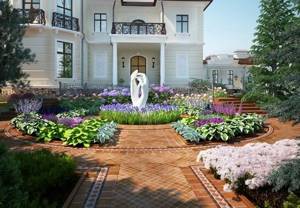
This is what she might look like today
Rest zone
A place to relax is usually located behind the house. A lawn is also laid out here, but not the classic English one, but made up of forbs, with groups of green spaces scattered across it and winding paths.
For a recreation area, choose a secluded place hidden in the shade of trees. Here they put a wooden gazebo entwined with climbing plants, wooden garden furniture, benches, swings, and a barbecue.
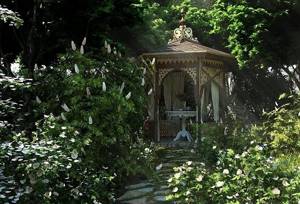
Next to the gazebo you can plant not only decorative but also berry bushes, such as currants or raspberries
Paths and platforms
In the manor style, clear straight paths are not accepted. Most often they are winding, meandering between trees, but they always lead to their destination - to a gazebo, stream, bathhouse. The paths are lined with a border of perennials or low shrubs.
For paving, as a rule, natural stone and gravel are chosen, but modern materials can also be used. In this case, preference is given to concrete tiles with the texture of natural stone. Paving stones are suitable for the access area; for the central square and garden paths - tiles with uneven edges in a “antique” manner.
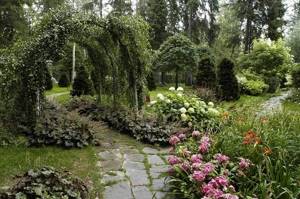
Grass-covered garden paths made of “wild” stone create the effect of a slightly neglected garden
Landscape design project from Sad-dizain
More details
Small architectural forms
In addition to traditional gazebos, pergolas and arches similar to French beurceaux, but entwined not with roses, but with hops or maiden grapes, would be appropriate in the garden.
Previously, on noble estates it was customary for the younger generation to maintain small rabbit farms and children's poultry yards. Our children are far from such entertainment, but a bird feeder, birdhouse, house for a hedgehog or squirrel would not hurt.
Manor gardens rarely did without natural reservoirs. If there is nothing like this on your site, you can build a small artificial pond. Most often this is a stream or pond, along the banks of which moisture-loving plants are planted - weeping willows, hostas, turf, irises, cattails. On the shore of the pond, a platform is built from boards or stones, and a bridge is thrown across the stream.
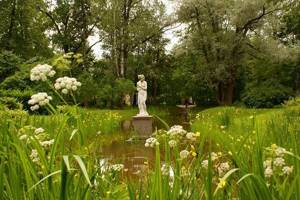
Landscape pond - a real decoration of the garden
Rest zone
It is better to arrange a recreation area in a shady part of the garden with tall, spreading trees. Here you can sit in a gazebo with a book or handicrafts, relax in a comfortably swinging hammock, ride a rope swing or play with children on a specially equipped playground.
Although there are certain canons of site design, modern landscape designers never tire of offering non-standard solutions using the latest materials, which helps create a unique and comfortable garden in the Russian style.
- Author: Ilona Lukina
Rate this article:
- 5
- 4
- 3
- 2
- 1
(11 votes, average: 4.5 out of 5)
Share with your friends!
